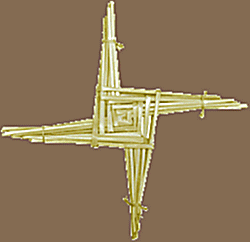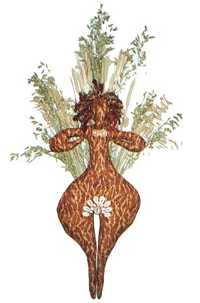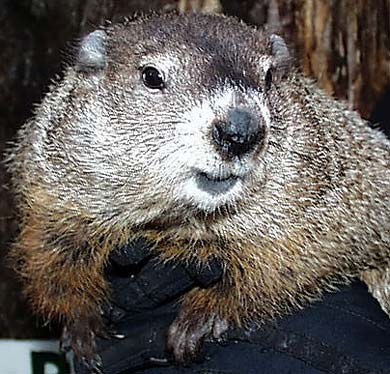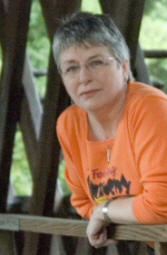|

Imbolc:
The Time of Fire in the Belly
By Brenda Sutton
It's the middle of January. My daffodil bulbs are poking their pale green shoots out of the cold ground, just waiting for their annual rude awakening. Spring is definitely on the way.
I'm a Wiccan, so when the Wheel of the Year rolls around to this position, me and mine look forward to the fire and milk celebration of Imbolc (pronounced im-mulk.) Imbolc happens near the beginning of February, usually February 1 or 2, but sometimes it's right and proper to wait until the fire goddess Brigid turns Her head toward the sun.
 Brigid has many names; she's also known as Brighid, Bríde, Brigit, and Brìd. In Her honor, the Irish call the Imbolc holy day Lá Fhéile Bríde (the Feast of Bride), the Scottish name it Latha Fhèill Bríghde (the Festival of Brigid), and the Welsh say Gwyl Ffræd (Brigit's Feast). Her element is fire. She inspires the mind to create poetry. Brigid blesses holy wells, healers and blacksmiths, and Her symbol is a weaving of straw called a Brigid's Cross. You can find these Celtic talismans blessing doorways all over Ireland. She is the Triple Goddess — Maiden, Mother, and Crone — who offers us light in the season of darkness. Brigid has many names; she's also known as Brighid, Bríde, Brigit, and Brìd. In Her honor, the Irish call the Imbolc holy day Lá Fhéile Bríde (the Feast of Bride), the Scottish name it Latha Fhèill Bríghde (the Festival of Brigid), and the Welsh say Gwyl Ffræd (Brigit's Feast). Her element is fire. She inspires the mind to create poetry. Brigid blesses holy wells, healers and blacksmiths, and Her symbol is a weaving of straw called a Brigid's Cross. You can find these Celtic talismans blessing doorways all over Ireland. She is the Triple Goddess — Maiden, Mother, and Crone — who offers us light in the season of darkness.
Every winter hearthfire and candles lit in Her name are invocations for the renewal of the Sun, for the return of light and warmth to the world. Rituals of Imbolc involve hearth and home, hearty stews and fiery drink, like whiskey punch (which is both medicinal and tasty.) Before leaving to attend Imbolc, each family's hearthfire is extinguished, the coals and ashes swept away. In the temple of the circle we ask Brigid's blessing upon our candles, wicks, oils—all methods of fire and light. A huge bonfire blazes in the center of the circle, and each family's hearthfire is then rekindled with a tended coal from that bonfire. This may seem an archaic rite in this age of electricity, but it's really a reminder of an ancient test of faith. Modern pagans remember their ancestors whose survival of the cold February and March yet to come depended upon their hearth fire, and yet who still extinguished those fires with perfect trust in Brigid's perfect love.1
 Another important part of the Imbolc celebration involves the creation of reverence. On Imbolc Eve, young, unmarried women come together to create a straw-worked corn dolly called the Bride Og, the "young Brigid." They stay up all night working on this project, dressing and adorning Her with greenery, shells, beautiful stones and ribbons, and lying her in a decorated "Brigid's Bed." They lay special clothing or jewelry outside for Brigid's blessing when She passes by in the night. For the remainder of the year, that clothing is considered to be lucky or to have healing properties. Another important part of the Imbolc celebration involves the creation of reverence. On Imbolc Eve, young, unmarried women come together to create a straw-worked corn dolly called the Bride Og, the "young Brigid." They stay up all night working on this project, dressing and adorning Her with greenery, shells, beautiful stones and ribbons, and lying her in a decorated "Brigid's Bed." They lay special clothing or jewelry outside for Brigid's blessing when She passes by in the night. For the remainder of the year, that clothing is considered to be lucky or to have healing properties.
A month earlier at Yule, Wren Boys led the wassailing parades. On Imbolc Morn, the young women take their turn, processing Bride Og in her bed from house to house with great reverence. The older and married women, who have also stayed up all night, greet the procession with food or small coins. In the morning, the young women are visited by the young men, who treat them with reverence and respect. With the rise of patriarchy, the goddess was transformed into St. Brigid, and Christianity kept many of these pagan traditions, incorporating them into their celebrations of Candlemas.2,3
Oddly enough, Imbolc is also connected to sheep. The word imbolc in Gaelic means 'in the belly' and refers to the gestation period of ewes. Another name for Brigid's Day is Oimelc, which means "ewe's milk." Sheep, for some strange reason, pick this still frigid time of year to deliver their lambs—the emergence of life from the season of death.
Ancient pagans looked first to the sky for the signal that the world turned toward the light, using the movement of stars as their celestial calendar. But often the skies didn't cooperate, obscured by blankets of clouds. Besides all of those labouring sheep, what other signs pointed to this movement of the Wheel? Well, if you can't look up, then look down...at the ground.
-
-
Thig an nathair as an toll
La donn Bride,
Ged robh tri traighean dh' an
Air leachd an lair.
"The serpent will come from the hole
On the brown Day of Bride,
Though there should be three feet of snow
On the flat surface of the ground." 4
 Predicting the weather by watching when animals like serpents and fox and badgers ended their season of hibernation...sounds like?...sounds like?...Ground Hog Day! Yessireebob, we're still practicing an ancient form of weather prognostication! The Wheel turns and turns and turns— and modern North Americans (being the practical people that they are) kept this old wisdom. Sure they've substituted a more prevalent local critter, but the lesson remains. If the animal feels that the earth has warmed enough to venture outside, the chances are pretty good that the season has changed from winter to spring. And if the world's most famous ground hog, Punxsutawney Phil, sees his shadow, there will be six more weeks of winter. Predicting the weather by watching when animals like serpents and fox and badgers ended their season of hibernation...sounds like?...sounds like?...Ground Hog Day! Yessireebob, we're still practicing an ancient form of weather prognostication! The Wheel turns and turns and turns— and modern North Americans (being the practical people that they are) kept this old wisdom. Sure they've substituted a more prevalent local critter, but the lesson remains. If the animal feels that the earth has warmed enough to venture outside, the chances are pretty good that the season has changed from winter to spring. And if the world's most famous ground hog, Punxsutawney Phil, sees his shadow, there will be six more weeks of winter.
Yes, it sounds odd—I know—but he's really a smart guy, Phil. The little fellow knows that in winter the snowy world is warmer when there are clouds in the sky. He knows that the earth loses its heat faster on a clear sunny day. No clouds=shadow=more winter. Very smart guy, Phil. 5
So here's to Imbolc, the celebration of fire and milk, sheep and ground hog, corn dollies and medicinal whiskey punch, and the Triple Goddess, Brigid! May She bless you with poetry in your soul, and fire in your spirit, health in your home.
References:
- Chadwick, Nora (1970) The Celts London, Penguin. ISBN 0-14-021211-6 p. 181
- McNeill, F. Marian (1959, 1961) The Silver Bough, Vol. 1-4. William MacLellan, Glasgow p.11-42
- Carmichael, Alexander (1900) p. 166-8 The Sacred Texts Archive
- Carmichael, Alexander (1900) Carmina Gadelica: Hymns and Incantations, Ortha Nan Gaidheal, Volume I, p.169 The Sacred Texts Archive
- Chadwick (1970) p. 181
 Brenda Sutton is the publisher of Mythic Passages, Operations Director, Corporate Secretary, and Office Administrator for Mythic Imagination Institute. She is an award-winning singer/songwriter with the internationally reknown band Three Weird Sisters. She works in a support and consultant capacity for the non-profit music organization Interfilk, and maintains their website. She is freelance writer whose work has appeared in newspapers and magazines. She is also the mother of five, grandmother of two.
Brenda Sutton is the publisher of Mythic Passages, Operations Director, Corporate Secretary, and Office Administrator for Mythic Imagination Institute. She is an award-winning singer/songwriter with the internationally reknown band Three Weird Sisters. She works in a support and consultant capacity for the non-profit music organization Interfilk, and maintains their website. She is freelance writer whose work has appeared in newspapers and magazines. She is also the mother of five, grandmother of two.
Read more about Imbolc
Return to the Mythic Passages Menu
Subscribe to the Mythic Passages e-zine
|

